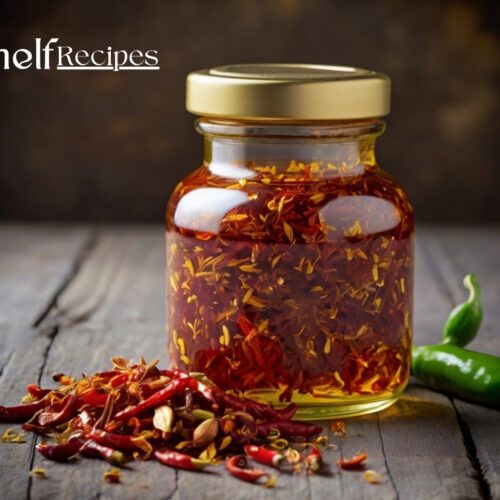
Chili oil is a versatile condiment that adds heat and depth to any dish, from noodles and dumplings to marinades and stir-fries. Making it at home allows you to customize the spice level and infuse the oil with unique flavors. In this guide, we’ll walk you through a simple chili oil recipe, with tips on ingredients, preparation, and variations.
Table of Contents
What is Chili Oil?
Chili oil is a popular condiment made by infusing oil with dried chili flakes, spices, and aromatics. Known for its vibrant color and intense flavor, chili oil can add a spicy kick to your favorite dishes, transforming everyday meals with just a drizzle.
Benefits of Making Your Chili Oil
Homemade chili oil offers several advantages over store-bought versions:
- Customization: Adjust spice levels, aromatics, and oil types to your liking.
- Freshness: No preservatives or artificial ingredients—just pure, fresh flavors.
- Cost-Effective: Making it at home is often cheaper than buying premium chili oil brands.
- Healthier Option: Control the type of oil used and avoid unnecessary additives.
Essential Ingredients
While chili flakes are the star ingredient, the right combination of aromatics and spices will enhance its flavor.
Chili Flakes & Peppers
Different chili varieties offer unique heat levels and flavors:
- Mild: Kashmiri chili, Aleppo pepper (fruity and mildly spicy).
- Medium: Thai chili flakes, Gochugaru (Korean chili powder).
- Hot: Sichuan chili flakes, dried bird’s eye chilies.
Aromatics & Spices
- Garlic & Ginger: Add warmth and depth.
- Sichuan Peppercorns: Provide a tingly, numbing sensation.
- Star Anise & Cinnamon: Create a subtle sweetness and complex aroma.
- Bay Leaves & Cloves: Offer earthy undertones for balance.
Types of Oil
The choice of oil impacts the overall flavor:
- Neutral Oils (Best for classic chili oil): Vegetable, canola, sunflower oil.
- Nutty Oils (For deeper flavor): Peanut, and sesame oil (mix with neutral oil to avoid burning).
- Fruity Oils (For Mediterranean-style chili oil): Olive oil, avocado oil.

Chili Oil
Ingredients
- 1 cup of oil neutral oils like vegetable or canola work best
- 1/4 cup of dried chili flakes adjust to taste
- 2 cloves of garlic minced
- 1 small piece of ginger thinly sliced
- 1-2 teaspoons of Sichuan peppercorns optional, for a tingly, numbing effect
- 1 star anise optional for a warm, aromatic flavor
- 1 cinnamon stick optional
Instructions
Step 1: Prepare Your Ingredients
- Measure out the chili flakes, peppercorns, and other aromatics.
- Have a heat-proof jar or bowl ready for mixing the oil and spices.
Step 2: Heat the Oil
- In a small saucepan, warm the oil over medium-low heat.
- Add garlic, ginger, peppercorns, star anise, and cinnamon stick to the oil.
- Let the aromatics cook slowly, infusing the oil with their flavors. Maintain a low temperature to prevent the spices from burning.
Step 3: Combine Oil and Chili Flakes
- Once the garlic turns golden and the oil is fragrant, remove it from heat.
- Carefully pour the hot oil over the chili flakes in a heat-proof jar or bowl.
- Stir gently to evenly combine the ingredients.
Step 4: Let It Cool
- Let the chili oil cool to room temperature.
- Store in an airtight container in the fridge for up to one month.
Tips for Customizing Your Chili Oil
1. Adjust the Heat Level
- Increase spiciness by adding more chili flakes or using hotter chili varieties.
- Decrease heat by mixing in milder chili flakes or reducing the amount used.
- For extra heat, infuse whole dried chilies into the oil before pouring over the flakes.
2. Experiment with Aromatics
- Add dried shallots, green onions, or citrus peels for an extra dimension of flavor.
- Fresh herbs like rosemary or thyme can introduce subtle herbal notes.
- Infuse lemongrass or kaffir lime leaves for a Southeast Asian-inspired chili oil.
3. Use Different Oils
- Mix sesame oil with neutral oil for a nuttier, richer taste.
- Infuse coconut oil for a tropical, slightly sweet chili oil perfect for Asian dishes.
- Try smoked olive oil for a gourmet-style chili oil with a smoky undertone.
4. Enhance with Umami Boosters
- Add a spoonful of fermented black beans for a deep, savory taste.
- Mix in a dash of soy sauce or fish sauce for extra umami.
- Sprinkle in dried mushroom powder for an earthy, umami-rich chili oil.
How to Use Homemade Chili Oil
Chili oil is incredibly versatile—here are some creative ways to incorporate it into your cooking:
1. As a Condiment
- Drizzle over noodles, dumplings, or rice bowls for instant spice.
- Swirl into soups and broths for a rich, spicy flavor.
- Mix with soy sauce and vinegar for an easy dipping sauce.
2. In Cooking
- Add to stir-fries for a bold, spicy kick.
- Brush onto grilled meats, seafood, or tofu for extra flavor.
- Stir into scrambled eggs or omelets for a unique twist.
3. In Dressings & Marinades
- Mix with sesame oil and lime juice for a spicy salad dressing.
- Combine with honey and soy sauce for a flavorful marinade.
- Blend with mayonnaise or yogurt for a spicy dip or sandwich spread.
For more ways to use chili oil, check out this comprehensive guide on Epicurious that dives into recipes and pairing ideas.
Storage and Shelf Life
Homemade chili oil can last for up to a month when stored properly. Keep it in an airtight jar in the refrigerator to maintain freshness and prevent spoilage. If you prefer to store it at room temperature, use a sterilized glass jar and ensure all ingredients are fully submerged in oil to prevent contamination.
Pro Tips:
- Always use a clean, dry spoon when scooping out chili oil to avoid introducing moisture.
- For longer shelf life, strain out the solids after a week to prevent them from breaking down in the oil.To extend the
Variations of Chili Oil
Depending on regional preferences, chili oil can be made with different ingredients and preparation methods:
- Chinese-Style Chili Oil: Uses Sichuan peppercorns for a numbing effect and often includes fermented soybeans.
- Thai-Style Chili Oil: Incorporates fried shallots and sometimes fish sauce for added umami.
- Italian-Style Chili Oil: Features olive oil and dried chili flakes, commonly used in pasta dishes.
- Mexican-Style Chili Oil: Uses dried Mexican chilies like ancho or guajillo for a smoky flavor.
Common Mistakes to Avoid
To ensure your chili oil turns out perfectly every time, watch out for these common mistakes:
- Overheating the Oil – If the oil is too hot, it will burn the chili flakes and create a bitter taste. Keep the heat low and steady.
- Not Using Fresh Spices – Stale chili flakes and spices result in dull flavor. Always check for freshness before using.
- Using the Wrong Type of Oil – Strongly flavored oils like extra virgin olive oil can overpower the chili’s natural taste. Stick with neutral oils unless aiming for a specific flavor profile.
Final Thoughts
Making homemade chili oil is simple, fun, and highly customizable. Whether you like it mild or fiery hot, with fragrant aromatics or a pure chili kick, you can tweak the recipe to suit your taste. Experiment with different variations and enjoy the boost of flavor it adds to your meals!
Conclusion
Now that you know how to make your chili oil, the possibilities are endless! Enjoy experimenting with different spices, heat levels, and dishes to make this spicy condiment your own. check out our Meals for more ideas to elevate your cooking.






